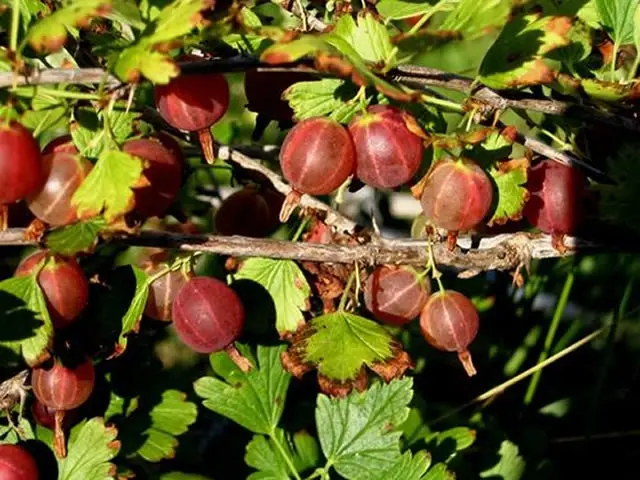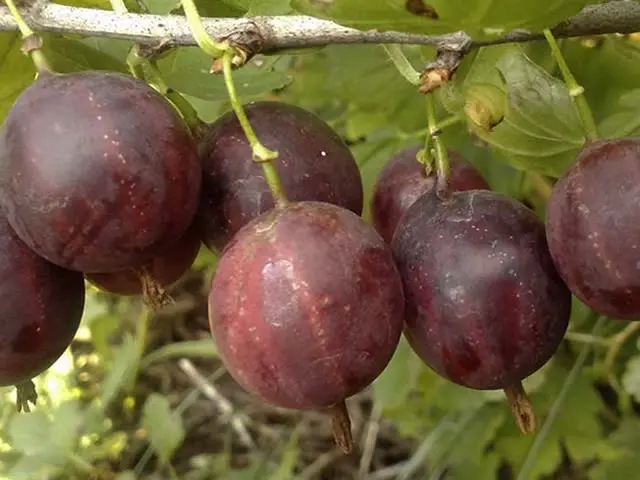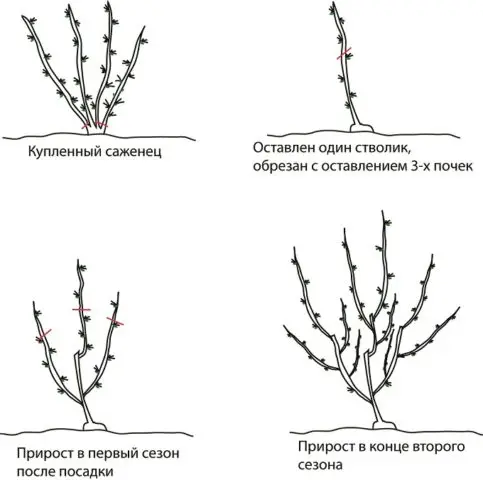Contents
Obtained by breeding research in the Moscow fruit and berry nursery, the gooseberry Smena was entered in the State Register of the Federation back in 1959. For many decades, the popularity of the variety has not decreased at all. Today, this berry crop is valued by gardeners for its unpretentiousness to climate and growing conditions, as well as for the incomparable taste of juicy, healthy fruits.
Description of the gooseberry variety Change
Medium-late in terms of maturation, the gooseberry of the Change variety is a medium-spreading shrub with strongly branching shoots. Light green young shoots turn gray with age, single spikes are placed along their entire length. There are no spikes on the crown. Medium and large green leaves have a three-lobed shape and a smooth surface on both sides, with a slight pubescence. The leaves are serrated along the edges and have a rounded top. Flower brushes of a light green variety, collected from 2 – 3 flowers, which, after pollination, turn into burgundy-red berries. The berries are medium-sized, weighing up to 2,2 g, abundantly showering the branches of the bush, which lean towards the ground under the weight of the crop. The taste of the fruit is pleasant, sweet and sour. The thorniness of the shrub is weak, rare, thin thorns are located on the branches one by one, without capturing the crown. This makes caring for it and harvesting it convenient and easy. Variety Change refers to self-pollinating, self-fertile, that is, for active fruiting, it does not require pollinating neighbors.
The gooseberry of the Change variety, a visual photo is presented below, is zoned throughout Our Country, except for Eastern Siberia and the North Caucasus.

Drought resistance, frost resistance
The frost resistance of the Change variety is good, without shelter, the gooseberry is able to tolerate up to 25 degrees below zero. Young seedlings at this temperature require shelter in winter. Gooseberries adapt to short periods of drought, but in order to get a good harvest, regular watering is necessary during flowering and fruit set.
fruiting, productivity
Gooseberry Change is a productive variety: about 6 kg of berries are harvested from one bush per season, which hold for a long time and do not crumble when the harvest is delayed. The fruits of this medium-late variety ripen in early to mid-July. The fruiting period lasts until the end of August.

Advantages and disadvantages
The advantages of gooseberry variety Change are the following features:
- resistance to diseases, in particular to powdery mildew;
- high frost resistance;
- excellent yield;
- long-term retention of ripe berries on the branches without shedding and cracking;
- self-fertility;
- versatility of fruit use.
However, the Change variety also has disadvantages:
- rapid growth of young shoots;
- resistance to pests;
- small fruits.
The description of the characteristics of the gooseberry Change is fully consistent with the reviews of experienced gardeners who grow it to obtain consistently high yields, despite weather conditions and care.
For more detailed, visual information about the gooseberry variety Change can be found in the video:
Features of reproduction
Gooseberry variety Change can be propagated:
- layering and cuttings;
- division of the bush.
For layering, strong branches are chosen, which in the spring are laid with fixation in shallow trenches dug around the bush. Soil is poured from above, watered. Gooseberry layering is cared for all summer, and in the fall they are planted in a permanent place. For cuttings, shoots aged 2 years are selected and shoots 20 cm long are cut off, which are then planted in separate ridges under the film, cared for and ventilated. With successful survival, young leaves appear on the shoots.
The division is carried out on old gooseberry bushes of the Change variety when it is required to rejuvenate them. After abundant watering, the bush is dug up, its roots are divided into parts with a sharp knife and seated.
Planting and care
Gooseberry planting Change is timed to coincide with autumn or spring. In the southern regions, it is advisable to plant plants in the fall – in early October. During the warm autumn period, seedlings have time to take root and prepare for winter. In regions with a colder climate, landing is carried out in early spring – in early or mid-April. An ideal place for gooseberries would be a sunny, well-lit and protected area from cold winds. A small hill is perfect, where the occurrence of groundwater is deep. The further development of the plant depends on the correctly chosen planting material. Therefore, seedlings for planting are chosen strong, with a developed root system, without the presence of mechanical damage. For better survival, before planting, young gooseberries are placed in a special bio-solution to stimulate root formation.
The landing algorithm consists of the following steps.
- The preparation of landing pits begins 2 weeks before planting.
- Pits are dug 40×40 in size at a distance of about 1 m from each other.
- The earth from the pit is mixed with compost or humus, mineral fertilizers are added – 50 g of superphosphate and potassium sulfate each.
- After that, soil is poured into the pit with a slide and a gooseberry seedling of the Change variety is placed vertically.
- Gently, in layers, sprinkle the earth and make sure that the root neck is not too deep.
- The soil is compacted, watered abundantly and mulched with fallen leaves or humus.
Growing rules
Despite the fact that the gooseberry of the Change variety is an unpretentious shrub that does not require special care, standard agricultural practices should be used for good yields. According to them, care is:
- in regular watering with warm water under the root;
- mulching the trunk circle with humus – to prevent the rapid evaporation of moisture and additionally fertilize the soil;
- fertilizing with mineral fertilizers from the age of 3;
- pruning – sanitary and forming.
After planting, for the first 2 years, the gooseberry of the Change variety does not need to be fertilized, since it has enough nutrients in the soil. In the future, a complex mineral fertilizer with nitrogen is applied annually in early spring. Do top dressing before the start of sap flow, immediately after sanitary pruning. When ovaries begin to appear, rotted compost is introduced directly into the soil. During fruiting, the gooseberry of the Change variety responds well to phosphorus-potassium fertilizers, which add 2 tbsp. for each adult bush. In late autumn, after the foliage has fallen, the mineral dressing of the shrub is repeated.
Sanitary pruning of the gooseberry variety Smena is carried out in early spring with the removal of dry, broken, damaged branches. Shoots are also cut out with signs of disease, cracked and old. Shaping pruning consists of trimming the tops by 2/3 of the length, if necessary. Bushes older than 7 years require anti-aging pruning, which consists in removing all shoots, leaving small stems with healthy buds.
Before the onset of winter, all the foliage of the near-trunk circle is raked and burned, while the soil is weeded and loosened. For preventive purposes, the crown is treated with fungicides. In regions with a small amount of snow, gooseberry branches are slightly bent down and covered with non-woven material. To protect gooseberries from rodents, spruce branches are used, which are tied around skeletal trunks so that the needles are located inside the bush. In addition, skeletal branches are wrapped near the ground with burlap, spunbond or nylon.

Pests and diseases
Gooseberry Change is a variety that is sufficiently resistant to diseases that are characteristic of this crop. With proper agricultural technology, the plant is not even exposed to the most common disease for gooseberries – powdery mildew. However, it is less resistant to anthracnose – the appearance of dark brown spots on the leaves. The fight against it consists in processing a solution of copper sulfate (50 g per 10 liters of water). Of the pests that prefer to settle on cultivated plants, the gooseberry Change is most susceptible to caterpillars and aphids. Get rid of them with insecticides.
Conclusion
Gooseberry Change for its properties and versatility of the use of fruits has become widespread among amateur gardeners. Strong, with dense skin, the berries are resistant to mechanical damage, which provides them with an attractive appearance in jams and compotes, as well as good transportability.









